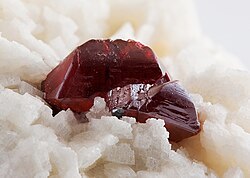
Red mercury is a discredited substance, most likely a hoax perpetrated by con artists who sought to take advantage of gullible buyers on the black market for arms.[1] These con artists described it as a substance used in the creation of nuclear weapons; because of the secrecy surrounding nuclear weapons development, it is difficult to disprove their claims completely. However, all samples of alleged "red mercury" analyzed in the public literature have proven to be well-known, common substances of no interest to weapons makers.[2][3]
- ^ Grant, P. M.; Moody, K. J.; Hutcheon, I. D.; Phinney, D. L.; Whipple, R. E.; Haas, J. S.; Alcaraz, A.; Andrews, J. E.; Klunder, G. L.; Russo, R. E.; Fickies, T. E.; Pelkey, G. E.; Andresen, B. D.; Kruchten, D. A.; Cantlin, S. (1998). "Nuclear forensics in law enforcement applications". Journal of Radioanalytical and Nuclear Chemistry. 235 (1–2): 129–132. doi:10.1007/BF02385950. ISSN 0236-5731. S2CID 97122353. Archived from the original on 17 January 2013. Retrieved 12 May 2010.
- ^ Lee, Rensselaer (May 1997). "Smuggling update". The Bulletin of the Atomic Scientists. 53 (3): 53. Bibcode:1997BuAtS..53c..52L. doi:10.1080/00963402.1997.11456737. ISSN 0096-3402.
- ^ "Cherry red and very dangerous". New Scientist. Retrieved 2024-05-10.